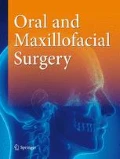Zusammenfassung
Hintergrund
Cherubismus ist eine seltene genetisch bedingte Erkrankung der Knochen, die fast ausschließlich den Ober- und Unterkiefer betrifft.
Fallbericht
Wir berichten über 3 männliche Patienten aus 3 aufeinander folgenden Generationen in Familie A und 10 betroffene Patienten in der Familie B. Beim jüngsten Patienten der Familie A fand sich neben dem Cherubismussyndrom eine Kraniosynostose. Der Vater und der Großvater zeigten neben den Cherubismussymptomen Trommelschlägelfinger.
Ergebnisse
Das Gen für den Cherubismus wurde auf Chromosom 4p16.3 lokalisiert. Aufgrund der Kraniosynostose wurde das FGFR3-Gen als Kandidatengen ausgeschlossen.
Resümee
Der Cherubismus zeichnet sich durch einen autosomal-dominanten Erbgang mit variabler Expressivität aus. Im Gegensatz zu Angaben der Literatur bestand bei Familie B eine unvollständige Penetranz auch beim männlichen Geschlecht.
Abstract
Background.
Cherubism is a rare fibro-osseous disorder that almost exclusively affects the maxilla and mandible.
Case report.
We report on three affected males in three generations in family A, and ten affected patients in family B. The youngest affected relative in family A also had craniosynostosis. His father and grandfather had cherubism and clubbed fingers.
Results and Discussion.
Cherubism was mapped to region 4p16.3. Because of the associated craniosynostosis, we excluded the FGFR3 gene as a candidate gene for cherubism. The inheritance pattern is autosomal dominant with variable expression . The penetrance is 100% in males and 50--70% in females. We found incomplete penetrance in males, which does not conform with all publications.






Literatur
Ayoub AF, el-Mofty SS (1993) Cherubism: report of an aggressive case and review of the literature. J Oral Maxillofac Surg 51: 702–705
Bianchi SD, Boccardi A, Mela F, Romagnoli R (1987) The computed tomographic appearances of cherubism. Skeletal Radiol 16: 6–10
Bradley TJ, Blankenship BJ, Stout RA, Wiston DA, Lung RE (1967) Bilateral giant cell reparative granulomas with appearance of cherubism: report of case. J Oral Surg 25: 555–560
Burland JG (1962) Cherubism: familial bilateral osseous dysplasia of the jaws. Oral Surg Oral Med Oral Pathol 15: 43–68
Caffey JW JL (1951) Familial fribrous swelling of the jaws. Radiology 56: 1–14
Cornelius EAJL (1969) Cherubism—hereditary fibrous dysplasia of the jaws. Roentgenographic features. Am J Roentgenol Radium Ther Nucl Med 106: 136–143
Fleuchaus PT, Buhner WA (1967) Cherubism treated by curettage and autogenous bone chips: report of case. J Oral Surg 25: 348–355
Graf A (1982) Klinisch-genetische Untersuchungen bei Cherubismus. Versuch einer Gesamtdarstellung und differentialdiagnostischen Abgrenzung. Dissertation, Ernst-Moritz-Arndt-Universität Greifswald
Hamner JE, Ketcham AS (1969) Cherubism: an analysis of treatment. Cancer 23: 1133–1143
Harris M (1968) Cherubism and the osteoclastoma. Oral Surg Oral Med Oral Pathol 25: 613–619
Hauenfelder H (1967) Der "Cherubismus" eine familiär auftretende Erkrankung der Kieferknochen. Dtsch Zahn Mund Kieferheilkd 49: 59–71
Hoppe W, Spranger J, Hansen HG (1966) Cherubismus: Familäre fibröse Dysplasie der Kieferknochen. Arch Kinderheilkd 174: 310–320
Ireland AJ, Eveson JW (1988) Cherubism: a report of a case with an unusual post-extraction complication. Br Dent J 164: 116–117
Jones WA (1933) Familia multiocular cystic disease of the jaws. Am J Cancer 17: 946–950
Kolesov AA, Panikarovskii VV, Roginskii VV (1973) Cherubism-swoebrasaja forma dyslasie tscheljustej. Stomatologiia (Mosk) 52: 27–31
Kramer IRH, Pindborg JJ (1992) Histological typing of odontogenetic tumors, 2nd edn. Springer, Berlin Heidelberg New York, pp 24–25
Mangion J, Rahman N, Edkins S, Barfoot R, Nguyen T, Sigurdsson A, Townend JV, Fitzpatrick DR, Flanagan AM, Stratton MR (1999) The gene for cherubism maps to chromosome 4p16.3. Am J Hum Genet 65: 151–157
McClendon J (1962) Hereditary fibrous dysplasia of the jaws. Oral Surg Oral Med Oral Pathol 15: 17–42
McKusick VA (1988) Mendelian inharitance in man, 8th edn. Johns Hopkins University Press, Baltimore London, p 143
Opitz C, Wittstock K (1990) Verlaufsbeobachtungen beim Cherubismus. Stomatol DDR 40: 60–63
Quan F, Grompe M, Jakobs P, Popovich BW (1995) Spontaneous deletion in the FMR1 gene in a patient with fragile X syndrome and cherubism. Hum Mol Genet 4: 1681–1684
Ramon Y, Berman W, Bubis JJ (1967) Gingival fibromatosis combined with cherubism. Oral Surg Oral Med Oral Pathol 24: 435–448
Regezi JA, Zarbo RJ, Lloyd RV (1987) Muramidase, alpha-1 antitrypsin, alpha-1 antichymotrypsin, and S-100 protein immunoreactivity in giant cell lesions. Cancer 59: 64–68
Timosca GC (1996) Le cherubisme: regression des lesions et regeneration osseuse spontanee. Rev Stomatol Chir Maxillofac 97: 172–177
Tiziani V, Reichenberger E, Buzzo CL, Niazi S, Fukai N, Stiller M, Peters H, Salzano FM, Raposo do Amaral CM, Olsen BR (1999) The gene for cherubism maps to chromosome 4p16. Am J Hum Genet 65: 158–166
Von Wowern N, Odont D (2000) Cherubism: a 36-year long-term follow-up of 2 generations in different families and review of the literature. Oral Surg Oral Med Oral Pathol Oral Radiol Endod 90: 765–772
Wayman JB (1978) Cherubism: a report on three cases. Br J Oral Surg 16: 47–56
Wuechner C, Hilbert K, Zabel B (1997) Human fibroblast growth factor receptor 3 gen (FGFR3): genomic sequence and primer set information for gene analysis. Hum Genet 100: 215–219
Author information
Authors and Affiliations
Corresponding author
Additional information
Ein Erratum zu diesem Beitrag ist unter http://dx.doi.org/10.1007/s10006-003-0458-z zu finden.
Rights and permissions
About this article
Cite this article
Petschler, M., Stiller, M., Hoffmeister, B. et al. Klinische und molekulargenetische Befunde bei Familien mit Cherubismus über 3 Generationen. Mund Kiefer GesichtsChir 7, 83–87 (2003). https://doi.org/10.1007/s10006-002-0444-x
Published:
Issue Date:
DOI: https://doi.org/10.1007/s10006-002-0444-x

